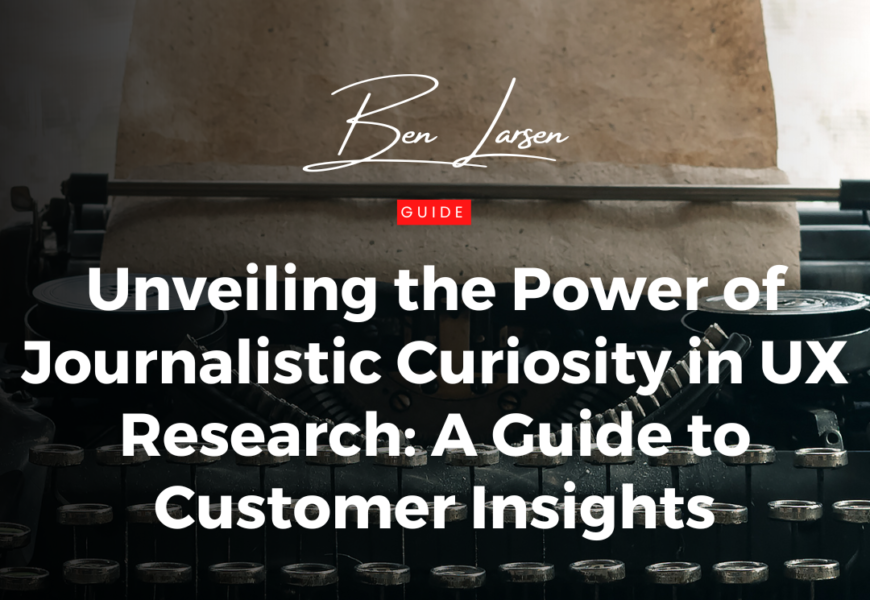The importance of customer insights in UX research
User experience (UX) researchers must understand the crucial role that customer insights play in shaping successful digital products and services. By delving deep into the needs, pain points, and behaviors of our users, we can uncover invaluable information that drives impactful design decisions. However, the process of gathering these insights can often be challenging, requiring a unique blend of empathy, critical thinking, and creative problem-solving.
In this article, we’ll explore how harnessing the power of journalistic curiosity can elevate our UX research practices, leading to a richer understanding of our customers and, ultimately, more meaningful user experiences. By adopting the mindset and techniques of seasoned journalists, we can unlock a treasure trove of insights that might have otherwise remained hidden.
Understanding the role of journalistic curiosity in UX research
Journalistic curiosity is the driving force behind the relentless pursuit of information and the unearthing of hidden truths. Journalists are masters at asking probing questions, uncovering underlying motivations, and painting vivid narratives that captivate their audience. These same skills can be incredibly valuable in the realm of UX research, where we strive to uncover the nuanced stories behind our users’ experiences.
By embracing a journalistic approach, we can move beyond the surface-level data and delve into the deeper, more complex aspects of user behavior. We can uncover the emotional drivers, the unspoken needs, and the unexpected pain points that shape the user journey. This level of rich, contextual understanding can then inform the design of experiences that truly resonate with our customers.
Applying journalistic techniques to gather customer insights
To harness the power of journalistic curiosity in our UX research, we can draw upon a variety of proven techniques:
- In-depth Interviews: Just as journalists conduct comprehensive interviews to gather firsthand accounts, we can employ a similar approach in our user research. By asking open-ended questions, actively listening, and probing for deeper insights, we can uncover a wealth of information that goes beyond the typical user survey or usability test.
- Contextual Observation: Journalists often immerse themselves in the environments they are investigating, observing the nuances of human behavior in real-time. In UX research, we can adopt a similar approach, observing users in their natural settings to gain a deeper understanding of how they interact with products and services.
- Investigative Research: Journalists are known for their meticulous research, scouring through various sources to uncover hidden connections and uncover the full story. As UX researchers, we can apply this same diligence, leveraging a wide range of data sources to build a comprehensive understanding of our users.
- Storytelling: Journalists have a knack for crafting compelling narratives that captivate their audience. In UX research, we can harness the power of storytelling to present our findings in a way that resonates with stakeholders and inspires impactful design decisions.
By weaving these journalistic techniques into our UX research practices, we can uncover a deeper, more nuanced understanding of our customers, ultimately leading to the creation of experiences that truly delight and empower them.
Conducting interviews with a journalistic mindset
One of the most powerful tools in a journalist’s arsenal is the in-depth interview. Similarly, in UX research, interviews can be a goldmine of customer insights, but only if we approach them with the right mindset.
As UX researchers, we must adopt a journalistic curiosity and a relentless pursuit of understanding. This means going beyond the surface-level questions and digging deeper to uncover the underlying motivations, pain points, and aspirations of our users.
During the interview process, we should strive to:
- Ask open-ended questions that encourage our participants to share their stories
- Actively listen and pick up on subtle cues that can lead us to unexpected insights
- Probe for deeper understanding by asking follow-up questions that delve into the “why” behind user behaviors
- Maintain a curious and non-judgmental attitude, allowing participants to feel comfortable sharing their authentic experiences
By approaching user interviews with a journalistic mindset, we can unlock a wealth of customer insights that can inform the design of truly impactful user experiences.
Utilizing storytelling in UX research for better customer understanding
Journalists are masters of storytelling, crafting narratives that captivate their audience and convey complex information in a memorable and engaging way. In UX research, we can harness the power of storytelling to present our findings and foster a deeper understanding of our customers.
By weaving the insights we gather into compelling narratives, we can bring our user personas to life and create a more vivid, empathetic connection between our stakeholders and the people they are designing for. This can be particularly effective when communicating research findings to cross-functional teams or executive stakeholders, who may not have the opportunity to directly engage with users themselves.
Moreover, the act of storytelling can help us identify and highlight the emotional factors that shape the user experience – the joys, frustrations, and aspirations that are often overlooked in more traditional data-driven approaches. By tapping into the emotional resonance of our users’ stories, we can inspire design decisions that truly speak to their needs and create experiences that leave a lasting impact.
Leveraging UX research findings to create impactful user experiences
As UX researchers, our ultimate goal is to translate the insights we uncover into the design of exceptional user experiences. By harnessing the power of journalistic curiosity, we can gather a wealth of customer insights that can directly inform and elevate the products and services we create.
When we approach UX research with a journalistic mindset, we don’t just collect data – we uncover the rich, contextual stories that reveal the true needs and motivations of our users. Armed with these insights, we can work closely with our design and product teams to craft experiences that anticipate and address the pain points our customers face, while also delighting them with unexpected solutions.
Moreover, by presenting our research findings through the lens of compelling narratives, we can inspire our stakeholders to see the world through the eyes of our users. This can lead to a deeper empathy and a shared understanding that drives more impactful design decisions, ultimately resulting in experiences that truly resonate with our customers.
Case studies: Successful examples of using journalistic curiosity in UX research
To illustrate the power of journalistic curiosity in UX research, let’s explore a few real-world case studies:
Case Study 1: Uncovering the Hidden Needs of Busy Professionals
In a recent UX research project for a productivity app, our team adopted a journalistic approach to understand the challenges faced by our target audience – busy professionals. Through in-depth interviews, we uncovered a surprising insight: many of our users were struggling with the emotional burden of feeling “always on,” constantly juggling work and personal responsibilities.
By delving deeper into this issue, we were able to uncover the root causes of this pain point, such as the fear of missing important communications and the inability to truly disconnect from work. Armed with these insights, our design team was able to create features that not only improved productivity but also addressed the underlying emotional needs of our users, leading to a significant increase in customer satisfaction and retention.
Case Study 2: Revealing the Unspoken Barriers to Digital Adoption
When conducting research for a new digital banking platform, our team recognized the importance of understanding the unique perspectives of older adults, a demographic that is often underserved in the digital space. Applying a journalistic mindset, we conducted contextual observations and in-depth interviews to gain a deeper understanding of the challenges this user group faced.
Through our research, we uncovered a range of unspoken barriers, from a lack of confidence in navigating digital interfaces to a deep-seated mistrust of online security. By sharing these insights with our stakeholders in the form of compelling user narratives, we were able to inspire the design of a more inclusive and accessible banking experience that addressed the specific needs of our older adult users, leading to increased digital adoption and customer loyalty.
These case studies demonstrate the transformative power of journalistic curiosity in UX research, highlighting how a deeper understanding of our customers can unlock the creation of experiences that truly resonate and delight.
Overcoming challenges in implementing journalistic curiosity in UX research
While the benefits of incorporating journalistic techniques into UX research are clear, there can be some challenges to overcome along the way. One of the primary hurdles is the potential resistance from stakeholders who may be more familiar with traditional, data-driven approaches to research.
To address this, we must be prepared to educate our stakeholders on the value of a more qualitative, story-driven approach. By presenting our research findings through the lens of compelling narratives and highlighting the emotional resonance of our user insights, we can demonstrate the powerful impact that journalistic curiosity can have on the design process.
Another challenge lies in the time and resource constraints that often come with UX research projects. Conducting in-depth interviews, contextual observations, and comprehensive investigative research can be time-consuming and resource-intensive. To overcome this, we must be strategic in our research planning, prioritizing the most critical user touchpoints and focusing our efforts on the areas that will yield the greatest insights.
Additionally, we may face resistance from users who are hesitant to share their personal stories or open up to a researcher with a journalistic approach. To build trust and encourage authentic participation, we must approach our research with empathy, sensitivity, and a genuine interest in understanding our users’ experiences.
By addressing these challenges head-on and continuously advocating for the value of journalistic curiosity in UX research, we can overcome the barriers and unlock the transformative power of this approach.
Tools and resources for incorporating journalistic techniques into UX research
To help you get started on your journey of incorporating journalistic curiosity into your UX research practices, here are some valuable tools and resources:
- Interview Guides and Question Banks: Curate a library of open-ended, probing questions that can help you uncover deeper insights during user interviews. Consider resources like the 5 Whys technique to dig deeper into the root causes of user behaviors.
- Contextual Observation Frameworks: Develop a structured approach to conducting contextual observations, such as the AEIOU framework or the POEMS model.
- Storytelling Templates and Techniques: Explore resources on effective storytelling, such as the Hero’s Journey or the Pixar Storytelling Formula, to help you craft compelling narratives from your research findings.
- Qualitative Data Analysis Tools: Leverage tools like Dovetail, Delve, or Dedoose to help you organize, analyze, and extract insights from your qualitative research data.
- Journalistic Writing Workshops: Consider attending workshops or online courses that focus on journalistic writing techniques, such as Poynter’s Essentials of Journalism or The New York Times’ Journalism Essentials.
By incorporating these tools and resources into your UX research practices, you can unleash the power of journalistic curiosity and create a more comprehensive, empathetic, and impactful understanding of your customers.
Conclusion: Harnessing the power of journalistic curiosity for valuable customer insights
In the ever-evolving landscape of user experience research, the ability to uncover deep, meaningful insights is the key to creating exceptional digital experiences. By embracing the mindset and techniques of seasoned journalists, we can elevate our UX research practices and unlock a wealth of customer insights that can truly transform the way we design for our users.
Through in-depth interviews, contextual observations, investigative research, and compelling storytelling, we can gain a richer, more nuanced understanding of our customers’ needs, pain points, and aspirations. Armed with these insights, we can work collaboratively with our design and product teams to craft experiences that not only meet the functional requirements of our users but also resonate with them on an emotional level.
As we continue to navigate the complex and ever-changing world of user experience, let us embrace the power of journalistic curiosity as a guiding force. By relentlessly pursuing the stories behind our users’ behaviors and elevating their voices through impactful narratives, we can create digital experiences that truly transform the lives of those we serve.
Subscribe to my free newsletter for more content showcasing the power of journalistic skills when applied to marketing and digital experience.


